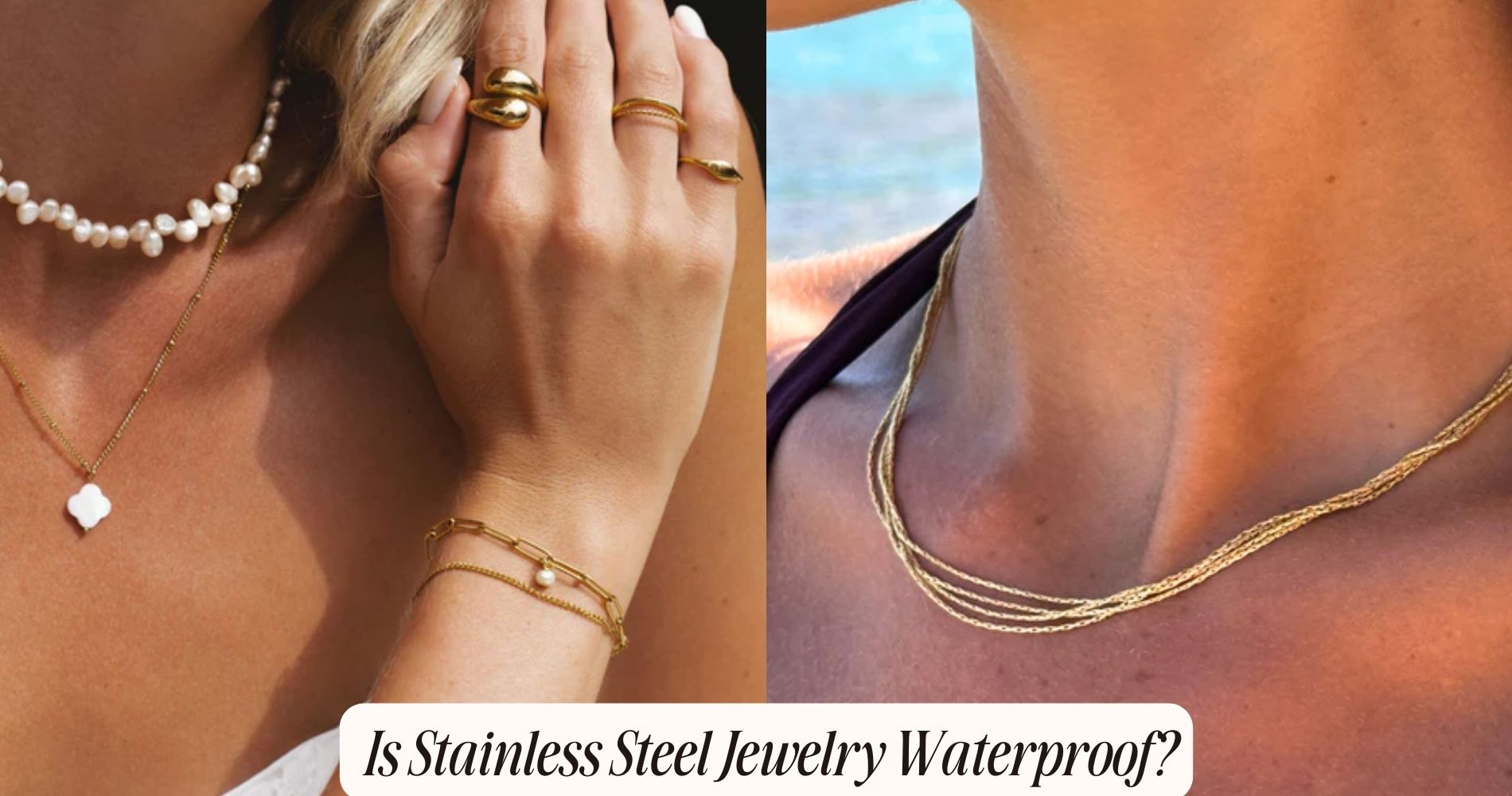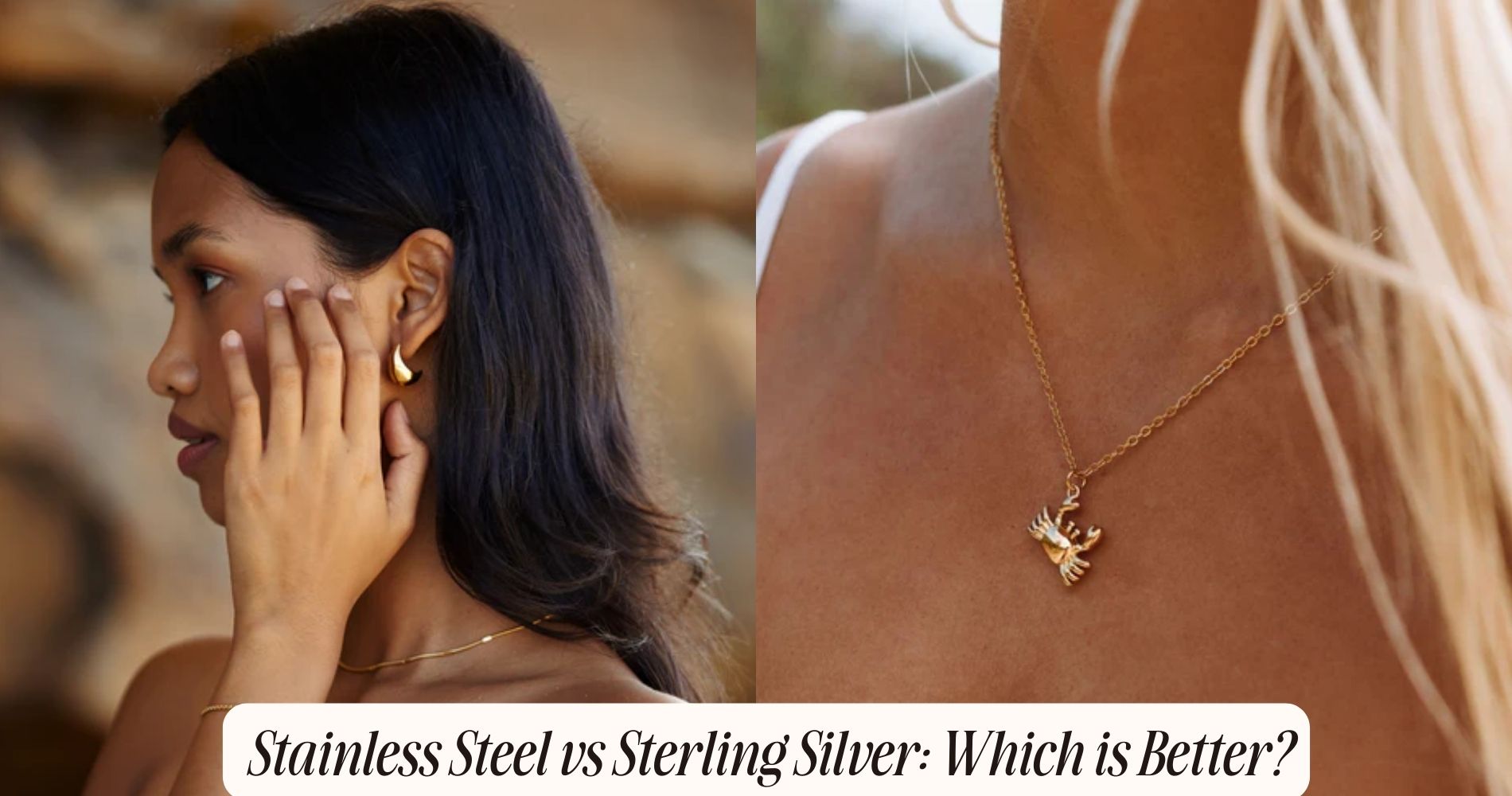
Is Stainless Steel Jewelry Waterproof?
Is stainless steel jewelry waterproof? Yes, stainless steel jewelry is highly resistant to water due to its chromium oxide layer, which prevents rust and corrosion. Standards like 304 and 316 stainless steel contain austenitic structures, enhancing their moisture resistance. However, exposure to chlorine or saltwater may weaken this protective layer over time. It remains durable and retains structural integrity with proper care. While it's not entirely impervious, stainless steel's impressive anti-corrosive properties and high nickel and molybdenum content guarantee longevity even with water exposure. For best results, understanding a few maintenance tips can enhance its lifespan and appearance. Explore these and more in our Hypoallergenic Jewelry collection.
Properties of Stainless Steel
Stainless steel, known for its exceptional resistance to corrosion and staining, is an alloy composed primarily of iron, chromium, and nickel. When considering stainless steel jewelry, you should understand its various properties, particularly its magnetic properties and thermal conductivity.
Firstly, the magnetic properties of stainless steel depend on its microstructure. Austenitic stainless steels, such as the commonly used 304 and 316 grades, are non-magnetic due to their face-centered cubic crystalline structure. Conversely, ferritic and martensitic stainless steels exhibit magnetic properties because of their body-centered cubic structure. However, for jewelry, austenitic grades are generally preferred because of their superior corrosion resistance.
Next, thermal conductivity in stainless steel is relatively low compared to other metals. For instance, the thermal conductivity of 304 stainless steel is approximately 16.2 W/m·K, while copper's thermal conductivity is around 398 W/m·K. This lower thermal conductivity means that stainless steel heats up and cools down more slowly, an advantageous property in maintaining the integrity and comfort of jewelry in various temperatures.
Understanding these properties lets you appreciate why stainless steel is a favored material for jewelry, offering a blend of durability, non-magnetic behavior, and controlled thermal response.
Composition and Resistance
Given its unique properties, the composition of stainless steel plays a pivotal role in its resistance to various environmental factors. Stainless steel is fundamentally a metal alloy, primarily composed of iron, carbon, and significant chromium content, typically ranging from 10.5% to 30%.
This chromium content is essential as it forms a passive layer of chromium oxide on the surface, which prevents further oxidation and enhances corrosion resistance.
You'll find that the additional alloying elements like nickel, molybdenum, and nitrogen further improve its mechanical properties and durability. For instance, nickel enhances toughness and ductility, while molybdenum increases resistance to pitting and crevice corrosion in chloride environments. Nitrogen contributes to the alloy's strength and resistance to wear and tear.
When you examine the metallurgical structure, stainless steel's austenitic and ferritic phases provide distinct advantages. Austenitic stainless steels, known for their exceptional corrosion resistance and non-magnetic properties, are particularly favored in jewelry making.
Ferritic stainless steels, though less common in jewelry, offer superior resistance to stress corrosion cracking.
These attributes make stainless steel an ideal choice for jewelry that needs to withstand daily wear and exposure to various elements without compromising its integrity or aesthetic appeal.
Water Exposure Effects
When you expose stainless steel jewelry to water, its rust and corrosion resistance becomes essential, largely due to its chromium content.
Chlorine and saltwater can compromise this resistance over time, potentially causing discoloration or pitting.
However, prolonged moisture exposure generally doesn't affect the structural integrity, provided the stainless steel is of high quality.
Rust and Corrosion Resistance
Exposure to water doesn't compromise stainless steel jewelry's rust and corrosion resistance due to its high chromium content. When stainless steel comes into contact with water, the chromium undergoes an oxidation process, forming a thin, invisible layer of chromium oxide on the surface. This passive layer greatly inhibits further electrochemical reactions that could lead to rust and corrosion, ensuring the metal's longevity.
Stainless steel typically contains at least 10.5% chromium, which is essential for its anti-corrosive properties. The chromium oxide layer acts as a barrier, preventing oxygen and moisture from penetrating the metal and initiating the oxidation process that leads to rust. As long as this layer remains intact, your stainless steel jewelry will maintain its appearance and structural integrity, even with frequent water exposure.
Moreover, stainless steel alloys often include other elements like nickel and molybdenum, which further enhance corrosion resistance. These elements contribute to the metal's ability to withstand various environmental conditions, including everyday water exposure.
Chlorine and Saltwater Impact
Chlorine and saltwater can accelerate the degradation of stainless steel jewelry by attacking the protective chromium oxide layer, necessitating extra care during exposure to these harsh environments.
When you're at the pool, chlorine damage is a significant risk. Chlorine, a potent oxidizing agent, can compromise the chromium oxide layer, which protects the underlying steel from corrosion. This degradation can lead to pitting and surface roughness, diminishing both the appearance and structural integrity of your jewelry.
In marine environments, saltwater corrosion is another critical concern. Saltwater contains high concentrations of sodium chloride, which can penetrate the chromium oxide layer and initiate localized corrosion, commonly known as crevice corrosion. Studies have shown that exposure to saltwater can reduce the lifespan of stainless steel by up to 50% compared to freshwater environments. Additionally, the combined effects of salt and oxygen can exacerbate the electrochemical reactions, accelerating the overall corrosion process.
To mitigate these risks, you should thoroughly rinse your stainless steel jewelry with fresh water after exposure to chlorine or saltwater. Additionally, drying the jewelry completely can help prevent residual moisture from fostering further corrosion. Taking these preventative measures can significantly extend the longevity of your stainless steel pieces.
Prolonged Moisture Exposure
Prolonged exposure to moisture can greatly impact the integrity and appearance of stainless steel jewelry by promoting corrosion and tarnish. Although stainless steel is corrosion-resistant, it's not entirely immune to the effects of continuous water contact. The chromium oxide layer that provides corrosion resistance can degrade over time if moisture barriers are inadequate.
You should regularly employ effective drying techniques to mitigate moisture accumulation. After exposure to water, promptly dry your stainless steel jewelry using a microfiber cloth. This minimizes water spots and reduces the risk of corrosion. Consider storing the jewelry in moisture-absorbing containers with silica gel packets to maintain a dry environment when not in use.
Data shows that jewelry exposed to high humidity for extended periods exhibits increased surface oxidation and discoloration. Studies indicate that stainless steel items with a consistent moisture barrier, such as a clear protective coating, experience noticeably less degradation.
Regular maintenance and proper storage are critical for preserving the quality and appearance of your stainless steel jewelry.
Daily Wear and Tear
You'll find that stainless steel jewelry excels in resistance to moisture, maintaining its integrity even with frequent exposure.
Its durability over time is quantified by its high tensile strength and resistance to scratches and corrosion, ensuring longevity.
This makes stainless steel a top choice for daily wear without significant degradation.
Resistance to Moisture
How does stainless steel jewelry maintain its integrity against moisture during daily wear and tear?
Stainless steel is composed primarily of iron, chromium, and nickel. The chromium content, typically around 10.5-11%, forms a vital layer of chromium oxide on the surface. This layer is essential for providing robust resistance to moisture, effectively preventing oxidation and corrosion. Consequently, your jewelry retains its aesthetic appeal and remains untarnished.
Moreover, stainless steel's hypoallergenic properties guarantee that it won't react adversely with your skin, even when exposed to sweat or water. This characteristic is particularly advantageous for individuals with sensitive skin, as it minimizes the risk of irritation or allergic reactions.
Stainless steel's resistance to moisture is further supported by its performance metrics. In standard ASTM B117 salt spray tests, stainless steel exhibits remarkable endurance, often surpassing 1000 hours without significant signs of corrosion. This durability is a validation of its capability to withstand daily exposure to moisture, be it through washing hands, showering, or other routine activities.
Durability Over Time
Not only does stainless steel resist moisture, but its composition also guarantees exceptional durability against daily wear and tear. This metal is mainly composed of iron, chromium, and nickel, which contribute to its robust, corrosion-resistant nature. Chromium forms a thin oxide layer that prevents rust, ensuring your jewelry maintains its luster over time. Nickel enhances strength, making it less prone to scratches and dents compared to softer metals like gold or silver.
For daily wear, stainless steel jewelry offers a significant advantage: it's hypoallergenic. The minimal risk of allergic reactions makes it a preferred choice for individuals with sensitive skin. Unlike other metals that may cause irritation, stainless steel's hypoallergenic properties ensure comfort and longevity. Data suggests that less than 10% of people experience any allergic reaction to stainless steel, making it a safe option for most.
You'll find that stainless steel jewelry retains its appearance even after prolonged exposure to various elements. The alloy's high tensile strength and resistance to abrasion ensure minimal degradation over time. Therefore, stainless steel's durability makes it an ideal choice for everyday use, combining both aesthetic appeal and practical resilience.
Corrosion and Rust
Stainless steel jewelry plays a vital role in determining the corrosion resistance due to its high chromium content, which forms a protective oxide layer on the surface. This layer acts as a barrier, preventing oxidation and prolonging the lifespan of the jewelry. The alloy composition of stainless steel typically includes 10.5% to 30% chromium, along with varying amounts of nickel, molybdenum, and other elements. These components enhance the material's resistance to different environmental factors.
Material grades play an essential role in determining the corrosion resistance of stainless steel jewelry. For instance, 316L stainless steel, often referred to as surgical-grade, contains higher levels of molybdenum. This element greatly increases the jewelry's ability to resist pitting and crevice corrosion, particularly in chloride-rich environments like seawater.
In contrast, 304 stainless steel, while still highly resistant, offers slightly less protection against such conditions due to its lower molybdenum content.
Common Myths Debunked
You might've heard various misconceptions about stainless steel jewelry, but let's set the record straight with data-driven facts.
First, stainless steel's magnetic properties can vary depending on its alloy composition. Specifically, austenitic stainless steels (like 304 and 316L) are generally non-magnetic due to their high nickel content. Hence, if your stainless steel jewelry isn't magnetic, it's likely made from this type, ensuring high corrosion resistance and durability.
Another myth is that stainless steel's thermal conductivity affects its suitability for jewelry. Stainless steel has a thermal conductivity of approximately 15 W/m·K, lower than metals like silver (429 W/m·K) and gold (315 W/m·K). This lower thermal conductivity means stainless steel jewelry doesn't heat up or cool down as quickly, making it comfortable to wear in various environmental conditions.
Lastly, the belief that stainless steel can easily corrode is unfounded. The alloy's chromium content forms a passive layer, offering resistance to oxidation and rust. Data shows that stainless steel, particularly 316L, maintains its integrity even when exposed to moisture.
Maintenance Tips
Understanding these facts about stainless steel's resilience, let's explore the top practices to guarantee your jewelry remains in pristine condition. Employing proper cleaning techniques is crucial. Utilize a mild soap solution and a soft brush to remove grime. Rinse thoroughly with lukewarm water and dry with a lint-free cloth. Avoid abrasive cleaners, as they can damage the surface. For deeper cleaning, consider using an ultrasonic jewelry cleaner, which uses high-frequency sound waves to dislodge embedded dirt.
Storage solutions are equally important. Store your stainless steel jewelry in a dry, cool place to prevent any potential tarnish. Utilize anti-tarnish strips in your jewelry box, which can absorb moisture and other environmental elements. Ensure each piece is separated to avoid scratches; individual compartments or soft pouches are ideal.
Inspect your jewelry regularly for signs of wear or damage. Promptly address any issues to maintain the integrity and appearance of your pieces. For pieces with intricate designs or gemstones, professional cleaning every six months can maintain their luster.
Comparing Materials
When comparing materials for jewelry, consider the corrosion resistance, durability, and hypoallergenic properties that distinguish stainless steel from other metals like gold, silver, and titanium.
Stainless steel excels in corrosion resistance due to its chromium content, which forms a passive layer protecting it from oxidation and rust. In contrast, silver tarnishes easily when exposed to air and moisture, requiring frequent polishing to maintain its luster.
Regarding durability, stainless steel offers a hardness rating of approximately 5.5-6.3 on the Mohs scale, making it more resistant to scratches and deformation compared to gold, which rates around 2.5-3. Gold's softness, while contributing to its material aesthetics, makes it prone to damage over time. Titanium, with a hardness rating of 6-6.5, also provides excellent durability but comes with a higher cost and limited design flexibility.
Hypoallergenic benefits are another critical factor. Stainless steel's low nickel content makes it less likely to cause allergic reactions, unlike silver, which often contains alloyed metals that can irritate sensitive skin. Titanium also boasts hypoallergenic properties but lacks the affordable price point and widespread availability of stainless steel.
Therefore, stainless steel emerges as a versatile, cost-effective, and resilient option for jewelry.
Choosing Quality Pieces
Evaluating the quality of stainless steel jewelry involves scrutinizing factors such as grade, craftsmanship, and finishing techniques to guarantee longevity and aesthetic appeal. Start by examining the grade of stainless steel; 316L is highly recommended due to its superior corrosion resistance and hypoallergenic properties. Make sure the jewelry is free from surface irregularities and has a consistent finish, whether it's polished, brushed, or matte.
Craftsmanship is another critical parameter. Look for precision in the assembly and soldering of components. High-quality pieces often feature seamless joints and robust clasps. Additionally, the piece should have a weight that feels substantial yet comfortable, indicating the use of solid materials rather than hollow ones.
Pay attention to design trends and market demand when selecting your pieces. Contemporary styles such as minimalist designs, geometric shapes, and mixed metals are currently popular. Opt for pieces that not only meet these design trends but are also versatile enough to remain fashionable as market demand shifts.
Frequently Asked Questions
Can Stainless Steel Jewelry Tarnish Over Time?
Yes, stainless steel jewelry can tarnish over time, but its strong oxidation resistance notably delays this process. Regular cleaning and proper storage enhance tarnish prevention, ensuring your stainless steel jewelry maintains its luster longer.
Is Stainless Steel Hypoallergenic for Sensitive Skin?
You'll find stainless steel is generally hypoallergenic for sensitive skin due to its low nickel content and high corrosion resistance. However, individuals with severe nickel allergies might still experience reactions, so always test before prolonged wear.
How Should Stainless Steel Jewelry Be Stored?
To store stainless steel jewelry, use airtight storage containers to reduce humidity levels, as excessive moisture can cause tarnish. Choose silica gel packets within the containers to maintain ideal conditions and protect your jewelry's longevity.
Can Stainless Steel Jewelry Be Resized?
You can resize stainless steel jewelry, but it's challenging due to its hardness. Common resizing methods include cutting and welding, which require specialized tools. Cost factors involve labor intensity and complexity, potentially making it more expensive than other materials.
Does Stainless Steel Jewelry Have a Warranty?
You'll find that warranty coverage for stainless steel jewelry varies by manufacturer. Typically, warranty duration ranges from one to two years, covering defects in materials or craftsmanship. Always verify specific terms directly from the retailer.
Conclusion
To sum up, stainless steel jewelry is highly resistant to water, corrosion, and rust due to its chromium content, making it ideal for daily wear. While prolonged exposure to harsh conditions can cause minor surface changes, the material's durability guarantees longevity.
By regularly cleaning and promptly drying your pieces, you'll maintain their luster. When selecting jewelry, prioritize high-quality stainless steel to maximize these benefits. Trust in stainless steel for a reliable, low-maintenance accessory choice.
























Leave a comment
This site is protected by hCaptcha and the hCaptcha Privacy Policy and Terms of Service apply.